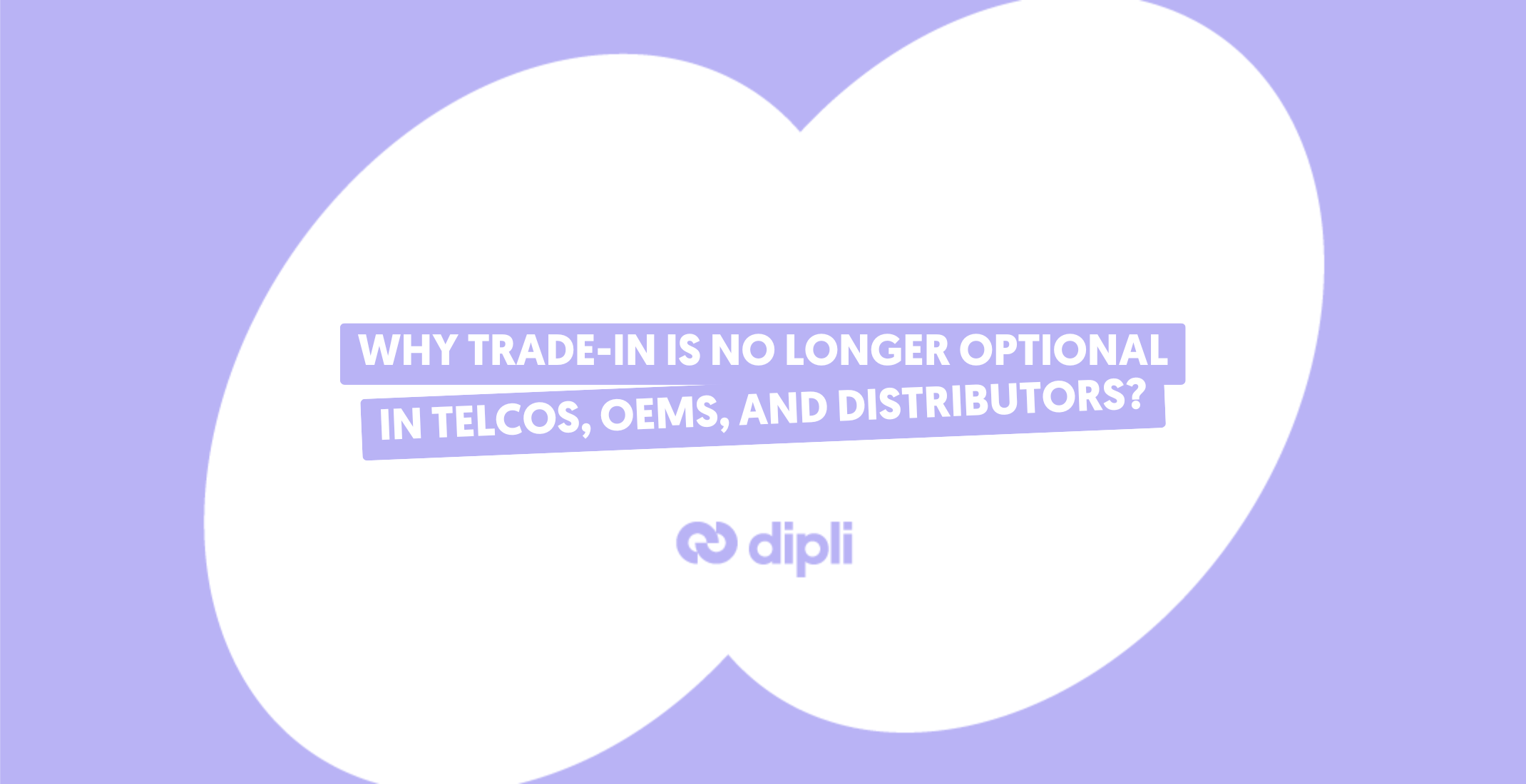What defines a good trade-in price?
23/04/2025
0 comments

Because a fair price isn’t fixed, it’s optimized.
When it comes to trade-in, price is everything. Whether you’re a telecom operator, electronics retailer, or OEM, the trade-in value you offer can make or break the user experience and your margin. But what really defines a good trade-in price?
At Dipli, we believe it’s not about guessing. It’s about precision, agility, and transparency. Here’s how we break it down.
The anatomy of a trade-in price
A trade-in price isn’t pulled out of a hat, it’s the result of dynamic market forces and operational realities.
1. Device model and specifications
Not all devices are created equal and neither are their trade-in values. The make, model, and technical specifications of a product form the foundation of its resale potential. That’s why this is the first filter in any trade-in pricing logic.
Flagship models (like iPhones and Galaxys) retain value better, especially when:
- Storage capacity is high,
- Color and finish are in demand,
- The model is still sold new or has just exited primary channels.
The model lifecycle
Each smartphone or tablet has a value trajectory that follows the rhythm of its lifecycle:
| Lifecycle stage | Impact on trade-in value |
|---|---|
| Launch window (0–6 months) | High value, but few trade-ins available |
| Active resale window (6–30 months) | Peak trade-in price + strong demand |
| Legacy stage (>30 months) | Trade-in value declines rapidly unless niche resale opportunities exist |
2. Condition and grading
A device’s physical and functional state can swing its value by 20 to 40%, depending on how it’s graded. That’s why professional, standardized grading is essential, both to set the right expectations for customers and to avoid margin erosion further down the chain.
At Dipli, every device entering our processing center goes through a precise, standardized grading protocol to ensure transparency, consistency, and trust across the ecosystem.
A single micro-scratch on an iPhone 14 Pro's screen can reduce its resale value by €40.
That’s the power of precision grading.
3. Market demand vs. supply
Trade-in pricing lives and breathes market logic. Behind every quote lies a simple truth: the value of a used device is driven by what buyers are willing to pay and how many units are in the pipeline.
Just like any liquid market, refurbished electronics follow the laws of demand and supply. If there’s an oversupply of iPhone 13 units flooding secondary markets, prices drop fast. If demand surges for entry-level Android devices due to corporate fleet renewals or back-to-school season, trade-in values can jump by 10% in a week.
After the iPhone 15 launch, the market saw a +42% surge in iPhone 12 and 13 trade-ins. Within 7 days, prices for those models fell by up to €25 per unit across most grades. Dipli’s dynamic pricing engine automatically adjusted to maintain competitiveness while protecting seller margins.
4. Resale channel logic
The trade-in price of a device is not only about what it is, it’s also about where it’s going. In the world of refurbished electronics, the resale destination shapes the value. A device destined for resale on a French marketplace doesn’t follow the same pricing logic as one shipped in bulk to a B2B distributor in Eastern Europe, or allocated to a corporate fleet replacement.
A trade-in price also reflects how and where the product will be resold:
- Online marketplaces,
- Corporate resale channels,
- Leasing and circular economy networks.
Why you can’t afford to use static trade-in pricing

In a fast-moving refurbished market, static pricing models are a strategic blindspot. If you're relying on fixed trade-in grids updated once a quarter, or worse, once a year, you’re not just leaving money on the table. You’re actively putting your profitability and customer experience at risk.
Static trade-in pricing means overpaying on slow-moving devices, losing customers to better offers, and sitting on inventory that depreciates week after week.
🔁 Don't price trade-in like, it's 2015
Price it like a modern, data-driven product. With Dipli, you stop gambling and start optimizing.
Whether you’re managing thousands of units per month or launching your first trade-in portal, our platform gives you the agility, visibility, and control to turn second life into first-class performance.
How Dipli delivers the most competitive trade-in price
What makes Dipli different? We don’t set prices, we let the market do it for you.
At Dipli, we simplify and optimize every step of the trade-in value chain. From real-time pricing to multi-buyer auctions and resale channel matching, our platform transforms trade-in into a strategic, data-driven engine. Whether you’re a telecom operator, retailer, or OEM, we help you offer the best price, capture more devices, and unlock full value from the second life of electronics.
- Auction-powered pricing
Every product on Dipli is listed in a controlled auction environment, where multiple professional buyers compete.
This ensures you always get the highest possible trade-in offer without negotiation.
- Multi-buyer network
We’re connected to the top refurbishers and wholesalers across Europe. They are all bidding in real time.
- Live market benchmarking
We sync pricing with resale markets across marketplaces and refurb platforms.
Our pricing engine adjusts automatically based on resale value and stock velocity.
How Dipli makes the market work for you
We don’t just follow market trends, we capture them, analyze them, and translate them into live price signals for our partners. Thanks to our network of professional buyers, we match every device with real-time demand and adjust prices daily, across Europe.
Auction-based pricing + real-time resale insights = an optimized trade-in value, every time.
By staying in sync with buyer appetites, resale velocity, and upcoming product drops, Dipli ensures you:
- Always offer the best price the market can support,
- Avoid stock devaluation from over-collecting low-demand models,
- Anticipate price shifts and adjust your trade-in strategy accordingly.
Why it matters for your business
Offering a transparent and optimized trade-in price does more than increase conversion. It builds trust, boosts take-back rates, and improves customer retention.
Whether you're running an in-store trade-in journey, an online buyback module, or a white-label plug-and-play platform powered by Dipli, your price is your first lever of impact.
Dipli simplifies the second life of electronic products.
An all-in-one tool for distributors, leasing companies, telecom operators and companies to manage the entire value chain in one place.
The platform connects the electronics industry to secondary markets; simply and securely. Trade-in and return management, refurbishment, omni-channel purchasing and distribution: Dipli covers and simplifies all stages of the circular economy.







Comments (0)